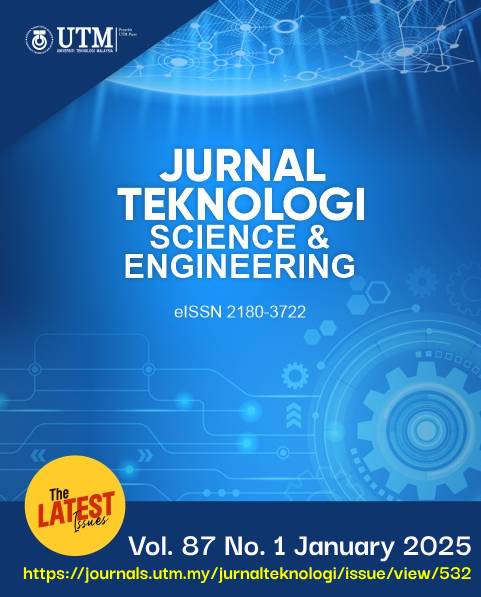FIELD PERFORMANCE OF HOT IN-PLANT PRODUCED ASPHALTIC CONCRETE WEARING COURSE (ACWC) WITH 30% RECLAIMED ASPHALT PAVEMENT (RAP)
DOI:
https://doi.org/10.11113/jurnalteknologi.v87.21713Keywords:
Hot-in plant recycling, ACWC20, 30% RAP, trial lay, field performanceAbstract
Hot in-plant recycling stands as an effective yet underutilized method in Malaysia for reusing pavement milling waste, resulting in insufficient established benchmarks and validated trials. The Utilization of Reclaimed Asphalt Pavement (RAP) can divert a significant amount of waste asphalt millings from landfills, while conserving energy and natural resources. This study focused on the recycled mixture, ACWC-30RAP, which integrated 30% Reclaimed Asphalt Pavement (RAP). In July 2022, a 400 m trial lay was conducted from KM413.90 to KM414.30 Southbound (SB), Section C3, along the PLUS North-South Expressway (NSE). Field tests were systematically conducted on both the ACWC-30RAP and conventional ACWC20 mixtures at different phases including month-6, month-9, and month-12 post-construction. The primary objective was to assess fundamental properties related to the structural stiffness of pavement layers as well as the pavement performance and condition for both trial sections using various field testing including Falling Weight Deflectometer (FWD) and Multi-Laser Profiler (MLP). Following the 12-month trial period, both the ACWC-30RAP and conventional ACWC20 mixtures experienced actual traffic loading and environmental conditions. Remarkably, the ACWC-30RAP demonstrated comparable field performance as the conventional ACWC20. This alignment in performance signified a promising avenue for employing the recycled mixture with high RAP content. Using ACWC-30RAP can also provide economic benefit, reducing the production cost by approximately 25%. In essence, the ACWC-30RAP had achieved an equivalent level of confidence to the conventional ACWC20 mixture, which was exclusively composed of virgin materials. cts.
References
Brock, J. D. and Richmond, J. L. Milling and recycling. R. Yang, S. Kang, H. Ozer, I. L. Al-Qadi. 2015. Environmental and Economic Analyses of Recycled Asphalt Concrete Mixtures based on Material Production and Potential Performance. Resour. Conserv. Recycl. 104: 141-151. https://doi.org/10.1016/j.resconrec.2015.08.014.
J. Montanez, S. Caro, D. Carrizosa, A. Calvo, X. Sanchez. 2020. Variability of the Mechanical Properties of Reclaimed Asphalt Pavement (RAP) Obtained from Different Sources. Constr. Build. Mater. 230: 116968. https://doi.org/10.1016/j.conbuildmat.2019.116968.
J. S. Chen, C. C. Huang, P. Y. Chu, K. Y. Lin. 2007. Engineering Characterization of Recycled Asphalt Concrete and Aged Bitumen Mixed Recycling Agent. J. Mater. Sci. 42: 9867-9876. https://doi.org/10.1007/s10853-007-1713-8.
Singh, Bhupendra, Nikhil Saboo, and Praveen Kumar. 2017. Effect of Short-term Aging on Creep and Recovery Response of Asphalt Binders. Journal of Transportation Engineering, Part B: Pavements. 143(4): 04017017. https://doi.org/10.1061/JPEODX.0000018.
Ameri, Mansourkhaki, & Daryaee. 2018. Evaluation of Fatigue Behavior of High Reclaimed Asphalt Binder Mixes Modified with Rejuvenator and Softer Bitumen. Construction and Building Materials. 191: 702-712. https://doi.org/10.1016/j.conbuildmat.2018.09.182.
Yang, S.-H., & Lee, L.-C. 2016. Characterizing the Chemical and Rheological Properties of Severely Aged Reclaimed Asphalt Pavement Materials with High Recycling Rate. Construction and Building Materials. 111: 139-146. https://doi.org/10.1016/j.conbuildmat.2016.02.058.
Miró, Rodrigo, et al. 2011. Evaluation of High Modulus Mixture Behaviour with High Reclaimed Asphalt Pavement (RAP) Percentages for Sustainable Road Construction. Construction and Building Materials. 25(10): 3854-3862. https://doi.org/10.1016/j.conbuildmat.2011.04.006.
Sang-Yum Lee, Tri Ho Minh Le, Yeong-Min Kim. 2023. Full-scale and Laboratory Investigations on the Performance of Asphalt Mixture Containing Recycled Aggregate with Low Viscosity Binder. Construction and Building Materials. 367: 130283. https://doi.org/10.1016/j.conbuildmat.2022.130283.
Timm, D. H., J. R. Willis and A. Kvasnak. 2011. Full-Scale Structural Evaluation of Fatigue Characteristics in High Reclaimed Asphalt Pavement and Warm-Mix Asphalt. Transportation Research Record. Journal of the Transportation Research Board. 2208: 56-63. https://doi.org/10.3141/2208-08.
Ameri, Mahmoud, Ali Mansourkhaki, and Daryoosh Daryaee. 2018. Evaluation of Fatigue Behavior of High Reclaimed Asphalt Binder Mixes Modified with Rejuvenator and Softer Bitumen. Construction and Building Materials. 191: 702-712. https://doi.org/10.1016/j.conbuildmat.2018.09.182.
Veeraragavan, Ram Kumar, et al. 2017. Laboratory Comparison of Rejuvenated 50% Reclaimed Asphalt Pavement Hot-Mix Asphalt with Conventional 20% RAP Mix. Transportation Research Record. 2633(1): 69-79. https://doi.org/10.3141/2633-09.
Bastola, Nitish & Souliman, Mena & Dessouky, Samer. 2022. Structural Health Assessment of Pavement Sections in the Southern Central States Using FWD Parameters. 209-218. https://doi.org/10.1061/9780784484609.023.
Marecos, V., Fontul, S., de Lurdes Antunes, M., & Solla, M. 2017. Evaluation of a Highway Pavement using Non-destructive Tests: Falling Weight Deflectometer and Ground Penetrating Radar. Construction and Building Materials. 154: 1164-1172. https://doi.org/10.1016/j.conbuildmat.2017.07.034.
Yaacob, Haryati & Hassan, Norhidayah & Hainin, Mohd Rosli & Rosli, Muhammad. 2014. Comparison of Sand Patch Test and Multi Laser Profiler in Pavement Surface Measurement. Jurnal Teknologi. 70. https://doi.org/10.11113/jt.v70.3497.
Chattanooga. 2007. TN: ASTEC, Technical Paper T-127.
Tebaldi, Gabriele, et al. 2018. Cold Recycling of Reclaimed Asphalt Pavements. Testing and Characterization of Sustainable Innovative Bituminous Materials and Systems. Springer, Cham. 239-296. https://doi.org/10.1007/978-3-319-71023-5_6.
Dughaishi, H. A., J. A., Bilema, M., Babalghaith, A. M., Mashaan, N. S., Yusoff, N. I. M., Milad, A. 2022. Encouraging Sustainable use of RAP Materials for Pavement Construction in Oman: A Review. Recycling. 7(3): 35. https://doi.org/10.3390/recycling7030035.
Osvaldo Munoz-Cáceres, et al. 2021. Mechanical Performance of Sustainable Asphalt Mixtures Manufactured with Copper Slag and High Percentages of Reclaimed Asphalt Pavement. Construction and Building Materials. 304: https://doi.org/10.1016/j.conbuildmat.2021.124653.
Mogawer, Walaa S., et al. 2016. Performance Characteristics of High Reclaimed Asphalt Pavement Containing Bio-modifier. Road Materials and Pavement Design. 17(3): 753-767. https://doi.org/10.1080/14680629.2015.1096820.
Hoyos, L. R., Puppala, A. J., Ordonez, C. A. 2011. Characterization of Cement-fiber-treated Reclaimed Asphalt Pavement Aggregates: Preliminary Investigation. ASCE J. Mater. Civ. Eng. 23(7): 977-989. https://doi.org/10.1061/(ASCE)MT.1943-5533.0000267.
Transportation Research Board. 1978. Recycling Material for Highways, NCHRP Synthesis No. 54. Transportation Research Board.
Henrikas Sivilevicius, Justas Braži ̄unas, Olegas Prentkovskis. 2017. Technologies and Principles of Hot Recycling and Investigation of Preheaeted Reclaimed Asphalt Pavment Batching Process in an Asphalt Mixing Plant. Applied Sciences. 7(11): 1104. https://doi.org/10.3390/app7111104.
D. Vandewalle, V. Antunes, J. Neves, A. C. Freire. 2020. Assessment of Eco-friendly Pavement Construction and Maintenance using Multi-recycled Rap Mixtures. Recycling. 5: 1-21. https://doi.org/10.3390/recycling5030017.
Ben Moins, et al. 2022. On the Road Again! An Economic and Environmental Break-even and Hotspot Analysis of Reclaimed Asphalt Pavement and Rejuvenators. Resources, Conservation and Recycling. 177. https://doi.org/10.1016/j.resconrec.2021.106014.
Downloads
Published
Issue
Section
License
Copyright of articles that appear in Jurnal Teknologi belongs exclusively to Penerbit Universiti Teknologi Malaysia (Penerbit UTM Press). This copyright covers the rights to reproduce the article, including reprints, electronic reproductions, or any other reproductions of similar nature.
















